Cryptocurrency analyst EXCAVO has declared the end of Bitcoin's bull market, predicting a 50% decline to $61,000 following the digital currency's $124,000 all-time high reached in July. The analyst cites three key market indicators suggesting Bitcoin has reached a cyclical peak and entered the early stages of a bear market phase.
What to Know:
- Bitcoin reached $124,000 all-time high in July before entering consolidation phase
- Analyst EXCAVO identifies three market-top indicators: universal optimism, corporate buying, and positive media coverage
- Prediction calls for 50% decline to $61,000 by September 2026 based on cycle theory
Market Top Indicators Signal Bearish Turn
EXCAVO's analysis centers on three traditional market-top signals that suggest Bitcoin's bull run has concluded. The first indicator, termed "Universal Optimism," reflects widespread bullish sentiment across the cryptocurrency space. Governments worldwide have begun accepting digital currencies and establishing strategic reserves, creating an environment of institutional validation that historically marks market peaks.
Corporate treasury accumulation represents the second warning sign. Public companies have purchased tens of billions of dollars worth of Bitcoin and Ethereum for their balance sheets.
This institutional adoption, while previously viewed as a bullish catalyst, now signals market saturation according to the analyst's framework.
The third indicator involves media coverage patterns. Positive cryptocurrency news currently dominates financial headlines, while investors demonstrate reluctance to sell positions. Many holders maintain price targets of $200,000, $300,000, or $500,000, suggesting unrealistic expectations that typically emerge near market tops.
Cycle Theory Points To September Reversal
The analyst's bearish outlook relies heavily on cryptocurrency cycle theory, which suggests markets follow predictable patterns of growth and decline. EXCAVO's model indicates approximately 151 weeks of growth followed by 51 weeks of decline, with the current growth phase nearing completion.
Based on this framework, a reversal zone beginning between September 13 and October 6 should mark the start of the next bear market. The analyst has positioned accordingly, selling all cryptocurrency holdings with plans to re-enter the market in September 2026.
EXCAVO's price target of $61,000 represents a 50-60% correction from Bitcoin's peak. This level aligns with historical bear market declines and provides what the analyst considers a "healthy" reset before the next bull cycle.
The analysis dismisses prospects for a traditional altcoin season. With over one million cryptocurrencies currently in existence, EXCAVO argues the market cannot support broad-based rallies similar to those seen in 2017. Instead, selective pumps will likely benefit only specific projects that attract institutional or retail interest.
Long-Term Outlook Remains Bullish Despite Near-Term Pessimism
Despite the bearish short-term forecast, EXCAVO maintains confidence in Bitcoin's long-term trajectory. The analyst expects Bitcoin to eventually reach $300,000, though not within the coming months as many investors anticipate.
"I have not become a bear forever. I believe Bitcoin will hit $300,000. But not in the coming months," EXCAVO stated. "It will be worth that in 2.5 years, after a healthy 50-60% correction from the peak."
This timeline suggests a potential bottom in late 2026, followed by renewed accumulation and eventual price appreciation. The analyst's strategy involves waiting through the predicted decline before re-establishing positions. The prediction challenges prevailing market sentiment, which largely expects continued gains following Bitcoin's summer peak. However, historical precedent suggests extended bull markets eventually give way to corrective phases.
Market Dynamics And Institutional Factors
Corporate adoption patterns support elements of EXCAVO's analysis. Companies like MicroStrategy have accumulated substantial Bitcoin reserves, creating a new dynamic in cryptocurrency markets. This institutional participation has provided price stability during previous corrections but may also indicate market maturation.
Government acceptance of digital currencies represents another shift in the regulatory landscape. Strategic reserves and official recognition have reduced uncertainty around Bitcoin's legitimacy. However, this institutional validation may also signal the end of Bitcoin's early-adoption phase.
The current market environment differs significantly from previous cycles due to increased institutional participation and regulatory clarity. These factors could either accelerate or moderate the predicted decline, depending on how institutions respond to price volatility.
Traditional cycle analysis may require adjustment given these structural changes in the cryptocurrency market. The presence of institutional investors with different risk profiles and investment horizons could alter historical patterns of boom and bust cycles.
Closing Thoughts
EXCAVO's analysis presents a contrarian view of Bitcoin's current market position, suggesting the July peak marked the end rather than a pause in the bull market. The predicted 50% decline to $61,000 challenges widespread optimism but aligns with historical cycle patterns and traditional market-top indicators.

